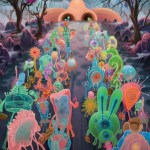bacteria
This air purifier ad from Sharp is a little creepy, in a Spongebob Squarepants way. I love how you can see their fluorescent organelles! Unfortunately I don't see anything here that resembles a virus, but with swine flu all over the news, this serves as a good reminder to wash your hands.
Ad by Takho Lau for ad agency M&C Saatchi of Hong Kong. Found via Next Nature
As apex organisms in the scope of Earth's multi-tiered web of life, most of us go about our day-to-day activities oblivious to the fact that bacteria are literally everywhere. Microorganisms can thrive in the most surprising locales—places totally inhospitable to human life. Recently, scientists from Harvard documented a flourishing bacterial ecosystem buried under 400 meters of ancient glacial ice; more common bacteria, Salmonella may lurk on your dinner plate, as a report citing 48,600 infections across ten states in 2008 attests; and if it's any indication from this scientific pursuit,…
Antarctica normally conjures images of white and blue, but the frozen continent can sometimes bear more unexpected colours. Take the Taylor Glacier - when geologist Griffith Taylor first explored it a century ago, he found a bizarre reddish stain that seemed to spill waterfall-like from the glacier's snout. The area became evocatively known as Blood Falls.
The source of the blood-red colour is an underground saltwater lake that was trapped by the encroaching glacier at least 1.5 million years ago. The temperature of the water is -5 Celsius, but it's so salty that it doesn't freeze. It'…
tags: bacteria, microbiology, TEDTalks, science, streaming video
This interesting video is a TEDTalk. TED -- for Technology, Entertainment, Design -- talks cover these topics as well as science, business, development and the arts. They are a daily video podcast of the best talks and performances from the TED Conference, where the world's leading thinkers and doers give "the talk of their lives" in 18 minutes. In this TEDTalk, Bonnie Bassler discovered that bacteria "talk" to each other, using a chemical language that lets them coordinate defense and mount attacks. The find has stunning…
tags: microbiology, astrobiology, new species, Indian Space Research Organization, bacteria
Bacterial colonies.
Image: Hub Testing Laboratory [larger view].
According to a recently published press release, three new species of bacteria have been discovered in the upper stratosphere by Indian scientists in an experiment conducted by the Indian Space Research Organization (ISRO). This discovery lends some credence to the hypothesis that life might have originated elsewhere in the cosmos and was seeded on Earth after colliding with a foreign body, perhaps a comet or asteroid, that was…
This is the fifth of eight posts on evolutionary research to celebrate Darwin's bicentennial.
Life can sometimes be a futile contest. Throughout the natural world, pairs of species are locked in an evolutionary arms race where both competitors must continuously evolve new adaptations just to avoid ceding ground. Any advantage is temporary as every adaptive move from a predator or parasite is quickly neutralised by a counter-move from its prey or host. Coerced onward by the indifferent force of natural selection, neither side can withdraw from the stalemate.
These patterns of evolution are…
The Japanese pinecone fish searches for food with living headlights. This ÂÂhand-sized fish harbours colonies of light-producing bacteria in two organs on its lower jaw. The beams from these organs shine forward, and when night falls and the fish goes searching for food, its jaw-lamps light the way.
Elsewhere in the Pacific Ocean, the Hawaiian bobtail squid also uses luminous bacteria, but theirs act as a cloaking device. They produce a dim glow that matches the strength of moonlight from above, hiding the squid's silhouette from hungry fish below. It's a mutual relationship; the squid gets…
Methicillin-resistant Staphylococcus aureus (MRSA) is very difficult to kill. This notorious "superbug" can withstand a broad and growing range of antibiotics, and is the leading cause of hospital infections in many countries. But it's not restricted to hospitals. According to studies coming in from all over the world, MRSA has found a new route into our bodies -piggyback.
Pig farms throughout the world have become breeding grounds for strains of MRSA that can jump from swine to humans. These strains have already been isolated in the Netherlands, Denmark and Canada, and now, the latest study…
The area collectively known as Austronesia covers half the globe. It stretches from South-East Asia and Taiwan, across New Guinea and New Zealand, to the hundreds of small islands dotted around the Pacific. Today, it is home to about 400 million people.
They are the descendants of early humans who spread throughout the Pacific in prehistoric times. These forebears are long dead but they left several unexpectedly important legacies that are evident in their modern descendants. The languages they used evolved and splintered into over 1,200 tongues spoken by modern Austronesians. The bacteria…
The mosquito Aedes aegypti sucks the blood of people from all over the tropics, and exchanges it for the virus that causes dengue fever - a disease that afflicts 40 million people every year. The mosquito has proven to be a tough adversary and efforts to drive it from urban settings have generally failed in the long-term. So how do you fight such an accomplished parasite? Simple - use a better parasite. In fact, try the most successful one in the world, a bacterium called Wolbachia.
Wolbachia's success rests on two traits. First, it targets the most diverse group of animals on the planet,…
The other day, one of my commenters stated that "a well-informed sixth-grader should be able to distinguish between MRSA and E. coli".
Here's a nutrient agar plate with some of the bacteria that we isolated from a local creek last fall. We identified our bacteria by sequencing the 16S ribosomal DNA, but for various reasons, that I won't go into here, we don't know which sequences belong to which colonies.
Figure 1. Bacteria isolated from a local creek.
I guess we need some well-informed sixth graders. ;-)
When normal bacteria are exposed to a drug, those that become resistant gain a huge and obvious advantage. Bacteria are notoriously quick to seize upon such evolutionary advantages and resistant strains rapidly outgrow the normal ones. Drug-resistant bacteria pose an enormous potential threat to public health and their numbers are increasing. MRSA for example, has become a bit of a media darling in Britain's scare-mongering tabloids. More worryingly, researchers have recently discovered a strain of tuberculosis resistant to all the drugs used to treat the disease.
New antibiotics are…
I don't usually do memes, but I couldn't resist this one and it gives me a chance to remind myself (and you) of some really amazing recent research. So without further ado...
Top Ten Bacteria - the Not Exactly Rocket Science edition
10. Carsonella ruddii
Possessor of the smallest bacterial genome known, C.ruddii has lost the majority of its genes and in doing so, its independence. Its genome is too small to allow it to survive on its own and it requires the room and board provided by its insect hosts whose genomes now host C.ruddii's genetic donations.
9. Pseudomonas syringae…
You are not alone. Even if you're currently reading this in complete isolation, you are still far from a singular individual. You're more of a colony - one human, together with microbes in their trillions. For every one of your own genes, your body is also host to thousands of bacterial ones. Some of the most important of these tenants - the microbiota - live in our gut. Their genes, collectively known as our microbiome, provide us with the ability to break down sources of food, like complex carbohydrates, that we would otherwise find completely indigestible.
Peter Turnbaugh from the…
Animal fossils are usually the remains of hard structures - bones and shells that have been petrified through enormous pressures acting over millions of years. But not all of them had such hard beginnings. Some Chinese fossils were once the embryos of animals that lived in the early Cambrian period, some 550 million years ago. Despite having the consistency and strength of jelly, the embryos have been exceptionally well preserved and the structure of their individual cells, and even the compartments within them, have been conserved in all their beautiful, minute detail.
They are a boon to…
Most of the planet's ecosystems are made of a multitude of different species, rich tangles of living things all interacting, competing and cooperating in order to eke out an existence. But not always - in South Africa, within the darkness of a gold mine, there is an ecosystem that consists of a single species, a type of bacteria that is the only thing alive in the hot, oxygen-less depths. It is an ecosystem of one, living in complete isolation from the Sun's energy.
This incredible and unique habitat was discovered by Dylan Chivian from the Lawrence Berkeley National Laboratory, leading a…
The plague, or the Black Death, is caused by a microbe called Yersinia pestis. In the 14th century, this microscopic enemy killed off a third of Europe's population. While many people consign the plague to centuries past, this attitude is a complacent one. Outbreaks have happened in Asia and Africa over the last decade and the plague is now recognised as a re-emerging disease. In 1996, two drug-resistant strains of plague were isolated from Madagascar. One of these, was completely resistant to all the drugs that are used to control outbreaks.
Anyone interested in bacteria can attest to…
ThinkGeek has a phenomenal new product line just in time for the holidays: Plush Microbes!
There are a ton of them, but below are some of my favorites:
There are also a ton of owner submitted action shots, documenting the fun that can be had with your microbes!
Nature isn't cruel, just indifferent
Tomato scare!
Easter egg hunting is more fun with Salmonella!
Thanks once again to Javie
There is a widespread belief, that being overweight or obese is a question of failing willpower, fuelled in no small part by food, fitness and beauty industries. But if we look at the issue of obesity through a scientific spyglass, a very different picture emerges. Genes, for example, exert a large influence on our tendency to become obese often by influencing behaviour - a case of nature via nurture. But it's not just our own genes that are important.
In terms of processing food, humans are hardly self-sufficient. Our guts are the home of trillions of bacteria that help to break down…
The complex cells that make up plants and animals only survive today because their ancestors formed partnerships with bacteria. In a previous post, I wrote about a microbe called Hatena, which provides us with a snapshot of what the early stages of this alliance might have looked like. Hatena swallows an alga which becomes an integrated part of its body.
Millions of years ago, the ancestors of complex cells did the same thing, taking in bacteria and merging with them to form a single creature. Today, these integrated bacteria are mitochondria, which provide us with energy, and…

